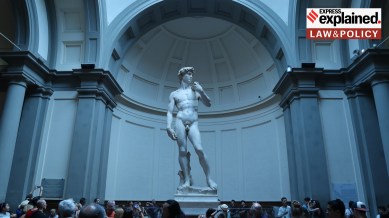Museum files lawsuits to ‘protect’ dignity of Michelangelo’s David: A look at Italy’s cultural heritage code
The artworks and monuments of Italy are governed by the Code of Cultural Heritage and Landscape, which protects them from 'disparaging and unauthorised commercial use'.

Completed in 1504, artist Michelangelo’s David is one of the most well-known symbols of Italian Renaissance art. Curators, however, now worry that the white marble statue’s religious and political significance is eroding due to thousands of fridge magnets,T-shirts, and other souvenirs — sold around Florence — that focus on David’s genitalia, according to a report by the Associated Press.
One such curator is Cecilie Hollberg, director of Galleria dell’Accademia — where the original David is kept — who has told the AP that she will be taking a “swift aim” at those profiteering from David’s image. At Hollberg’s behest, Florence’s attorney office has filed a series of court cases, invoking Italy’s landmark cultural heritage code. The law protects artistic and national treasures from “disparaging and unauthorised commercial use.”
monthly limit of free stories.
with an Express account.
What is Italy’s cultural heritage code?
The artworks and monuments of Italy are governed by the Code of Cultural Heritage and Landscape. According to Article 106 of the Code, public territorial bodies or cultural institutions (like museums) can request a concession fee for the use and reproduction of cultural property they have on consignment. They can also examine whether such uses are aligned with the artwork’s cultural purposes.
A peculiarity about the Code is its scope, which essentially extends “in perpetuity” the author’s copyright to the museum or institution that owns it. Vatican City also has similar legislative protections on its masterpieces and has moved courts in cases of unauthorised reproduction, including for commercial use and damaging an artwork’s dignity.
Although the Code, in its current form, has been in existence since 2004, the trend of museums and cultural institutes moving courts against unauthorised reproduction of their artworks for profit is relatively new.
What are such recent cases?
On April 20, 2023, the Italian Civil Court of First Instance of Florence deemed as “unlawful” the reproduction of Michelangelo’s David in GQ Italia magazine. The publication had juxtaposed David’s head on a model’s head for the magazine cover. Acting on a suit filed by the Galleria dell’Accademia, the court found that GQ didn’t obtain a licence from the museum, which owned the image rights to the sculpture.
In its suit, the museum invoked Article 9 of the Italian constitution, which protects symbols of the country’s cultural identity and history. The museum also mentioned Article 106 of the cultural heritage code which allowed it to demand concession fees for the commercial reproduction of David.
In 2022, the Civil Court of the First Instance of Venice restrained a German company, Ravensburger, from producing and selling a puzzle reproducing Leonardo Da Vinci’s Vitruvian Man.
These rulings challenge a widely held notion in the field of intellectual property rights (IPR) law, where such rights are protected for a specific period before they enter the public domain. According to the Berne Convention, which was adopted in 1886 and has been signed by more than 180 countries, including Italy, this protection period for artwork lasts until the artist’s lifetime plus 70 years.
Once a copyright expires, what happens to the artwork?
Usually, artworks are protected under copyright law. “Copyright is a legal term used to describe the rights that creators have over their literary and artistic works. Works covered by copyright range from books, music, paintings, sculpture, and films to computer programmes, databases, advertisements, maps, and technical drawings,” according to the World Intellectual Property Organization (WIPO).
When a work of art is not protected by copyright anymore, for instance, an old painting, it falls into the public domain, the European Union’s website says. In that situation, everybody should be free to make, use, and share copies of that work. However, this is not always the case, as some member states protect copies of those works of art.
The question of whether Italy’s cultural heritage code is at odds with this directive remains to be decided.